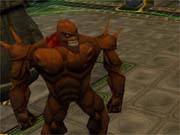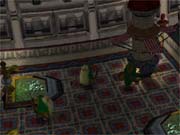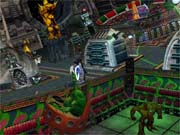Management has proven to be a lucrative source of inspiration for computer gaming. Almost every managerial career imaginable has been made into some sort of game. In addition to abstract business simulations, there have been games based on managing cities, transportation systems of various types, healthcare facilities, and amusement parks. Even pizza restaurants and dungeons have inspired games that are, when you get right down to it, simple exercises in planning and economics. A few of the better games in this genre have come from Bullfrog Productions, including Theme Park, Theme Hospital, and Dungeon Keeper. So it comes as little surprise that Startopia, a game in which you manage a space station, was designed by a company founded by ex-Bullfrog employees who were in some way or another involved with all three of these. In creating Startopia, Mucky Foot Productions (whose previous credits include the acclaimed action game Urban Chaos) has stuck closely to the management game formula but improved upon it in many ways. Startopia plays like a refined and expanded Dungeon Keeper--the main difference is that it has been relocated to deep space.

In Startopia's campaign, you are charged with rebuilding and running a series of derelict space stations. There's a brief tutorial that introduces the basic game mechanics, but it's in the campaign that you'll really learn how to play. The game follows a simple formula: You set up basic facilities and some moderately profitable ones and hire some aliens to run them. Then you make some money, build more-elaborate facilities, increase your income, promote/replace/fire employees, and repeat. There are numerous ways in which you can earn energy (the game's currency is also your stations' power source), and the 10 campaign missions slowly introduce you to the game's variety of tasks. In one, you'll learn how to build sick bays and heal injured and infirmed travelers. Another will introduce you to the game's simple but fun trading system. Others will teach you the basics of setting up the pleasure deck, which features shops and attractions to please guests and employees alike; and the biodeck, a strange area where you can control the climate and landscape to please the variety of aliens who'll visit your station and even harvest alien plants for tradable goods.
The variety of facilities and recreational facilities available in the game is striking. There are three types of hotels, several types of shops, a handful of bars, and numerous other types of places to keep your guests and residents occupied and happy. You can research and build these items yourself, buy blueprints from traders, or carry out any combination thereof. You must hire employees to run your operations, and you'll also build basic health facilities, manufacturing plants, security systems, prisons, and laboratories. Then you'll research improvements to all of these and build bigger, better facilities.

The campaign is fun, but it sometimes seems like an extended tutorial. There are only 10 missions, and for the most part they go by quickly--not necessarily easily, but quickly. There are some random elements--such as the appearance of traders, as well as the price and availability of their goods--that can make one or two of the missions very difficult or very easy, depending on what you're offered and when. But the real problem with the campaign is that it ends just when you're comfortable with the specifics of running your base. The last mission requires you to put all of your knowledge to use, but it seems like the game is just getting started.
Luckily, the game includes multiplayer options, as well as a flexible sandbox mode that lets you configure and tweak the game to your personal preferences and then begin building and running your station indefinitely--or not indefinitely, depending on how you set it up. You can create specific win conditions or just play freeform. And the abundance of random events--such as pilgrim ships seeking enlightenment from your monks, tourists seeking entertainment, and ambulance shuttles needing medical care--helps to keep things interesting. There's a great deal of freedom in the sandbox mode, and it almost makes up for the lack of predesigned missions.
One option you might want to consider turning off is the combat. Battle between administrators isn't bad-- it's just very simple. You have a fighting force, made up of what the game calls "combat ready" races. When it's time to take out an opponent, you must declare war, breach the doors to one of the enemy segments, and then hope you have more guys than he or she does. The only control you have over your troops is the ability to set muster points, areas where your troops will gather. Once the combat begins, they'll choose their targets on their own, though you can increase or decrease the importance of targets if you choose. But combat is so hectic that you'll likely just trust your forces' decisions.
The one minor problem with combat is that many of the combat races are also important to your operations. Greys run the sick bay, targs run your communication devices, and salthogs run your recyclers and factories. In a full-scale battle, vital areas of your station will grind to a halt, and you have no means of choosing who goes off to fight.

At least there's no obvious means, which is suggestive of Startopia's biggest problem. The manual packaged with the game is poor: It avoids any sort of useful information regarding the alien races that visit and live aboard your ship, and it provides almost no details regarding the ins and outs of your buildings. Are researchers more effective in quiet, secluded areas? Do kasvagorians enjoy shopping in combat stores more than in curiosity shops? Possibly, but you'll find no such information in the manual or the manual addendum included with the game. And there's little feedback during the game itself to help you draw such conclusions on your own. The manual also doesn't offer any mention of a few important interface options, including some really vital shortcuts that can save a lot of time once your station expands and your tasks become more numerous.
Startopia isn't well documented, which can be frustrating since it's essentially a very good game--it would probably be even better if it gave you a better sense of how to make your station run more efficiently. You can get extensive information with the in-game encyclopedia, but it often isn't very useful. This lack of information can initially get in the way, but playing Startopia is rather straightforward for the most part. Setting up and running a profitable and functional station can be easily done, and the game manages to be complex on the whole while keeping the various elements rather simple from a management perspective.
Moreover, the designers have taken more than just the formula from the Bullfrog games before it. Like Dungeon Keeper (and especially Dungeon Keeper II), Startopia looks great. The various alien races are mostly inventive and have a fair amount of personality as they roam around your station. You can zoom in and out as you see fit and can even go outside your station to look at the stars and planets beyond. The game looks good even at 640x480 resolution, which is a blessing considering how sluggishly it runs at anything higher. On a Pentium III with 128MB of RAM and a 64MB GeForce 2 card, the game is playable but slow at 800x600, but almost impossible to play at 1024x768.
The game can still get very sluggish even at low resolutions and also has an unpredictable tendency to crash. Luckily, Startopia includes a robust and original auto-save system, which cycles through three different auto-save locations and lets you easily get back into the game at several points in your recent management history.

The voice work in Startopia is as good as the graphics, and you'll learn to like the interruptions of your advisor and the visits from Arona, a trader who always sells high and buys low. Arona's visits are especially entertaining in the campaign, as his attempts to entreat you to buy his overpriced goods are always in line with the mission goals. And it's not just Arona's visits--the game is filled with humorous touches, including an abundance of science-fiction references and jokes about the aliens' interests and origins.
Startopia is very enjoyable overall, and even on a surface level, you'll find yourself consistently engaged by the number of tasks always at hand or just by watching the aliens go about their business on your station. It takes the best ideas of the management game genre and improves upon them while still remaining simple to play. And it's probably an even better game if you have the inclination to learn all of its ins and outs through continuous observation. It's a testament to Startopia's fundamentally sound design and attractive presentation that you'll enjoy it despite the fact that, at times, it'll make you feel slightly alienated.